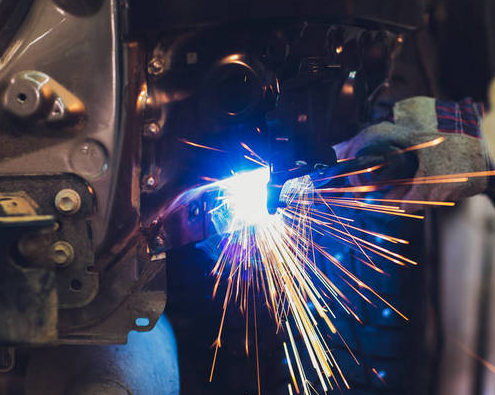Welding quality inspection – sealing inspection
Welding quality testing refers to the testing of welding results, to ensure the integrity, reliability, safety, and usability of the welded structure. In addition to the requirements for welding technology and welding processes, welding quality inspection is also an important part of welded structure quality management.
Let’s talk about the welding quality inspection method: sealing inspection.
So how to test the tightness of welded joints?
In general, the following methods can be used for detection:
1. Submersion test
Used for small containers or pipes subject to small internal pressure. Before the inspection, first, fill the container or pipe with compressed air at a certain pressure (0.4-0.5MPa), and then submerge it in water to check the sealing. If there is leakage, there must be bubbles in the water. This is also a common method for checking whether bicycle inner tubes are leaking.
2. Water test
Use the static pressure generated by the weight of water to check whether there are leaks in the structure. Mainly based on visual inspection, it is suitable for general welded structures that are not under pressure but require sealing.
3. Ammonia leakage test
The purpose is the same as the coal pump leakage test, and its sensitivity is higher than the kerosene leakage test. Before the test, first paste a white paper strip or bandage soaked in 5% mass fraction of HgNO3, aqueous solution, or phenolphthalein reagent on the side of the weld for easy observation, and then fill the container with ammonia or add 1% volume fraction of compressed nitrogen. Air.
If there is leakage, stains will appear on the white paper strip or bandage. Those soaked in 5% HgNO3 aqueous solution are black spots, and those soaked in phenolphthalein reagent are red spots.
4. Kerosene leakage test
It is used for welded structures subject to small internal pressure and requiring a certain degree of sealing. Kerosene has strong permeability and is very suitable for sealing inspection of welds. Before inspection, first brush lime water on one side of the weld for easy observation, and then brush kerosene on the other side of the weld. If there are penetrating defects, kerosene spots or kerosene bands will appear on the lime layer. The observation time is 15-30min.

5. Helium mass spectrometry test
The helium mass spectrometer test is currently the most effective means of sealing testing. The helium mass spectrometer is extremely sensitive and can detect helium with a volume fraction of 10-6. Before the test, the container is filled with helium, and then leaks are detected outside the weld of the container. The disadvantages are that helium is expensive and the inspection cycle is long.
Although helium has extremely strong penetrating power, it still takes a long time to penetrate extremely small gaps (such gaps cannot be detected by other means), and the leak detection of some thick-walled containers often takes dozens of hours. Appropriate heating can speed up leak detection.
6. Air tightness test
The Air tightness test is a routine inspection method for boilers, pressure vessels, and other important welded structures that require air tightness. The medium is clean air, and the test pressure is generally equal to the design pressure. The pressure should be increased step by step during the test.
After reaching the design pressure, apply soapy water on the outside of the weld or sealing surface and check whether the soapy water bubbles. Because there is a risk of explosion in the air tightness test, it should be carried out after the hydraulic pressure test is passed.
The air tightness test is different from the air pressure test:
1. Its purpose is different. The air tightness test is to test the tightness of the pressure vessel, and the air pressure test is to test the pressure resistance strength of the pressure vessel. Secondly, the test pressures are different. The air tightness test pressure is the design pressure of the container, and the air pressure test pressure is 1.15 times the design pressure.
The air pressure test is mainly to test the strength and sealing of the equipment, and the air tightness test is mainly to check the tightness of the equipment, especially small penetrating defects; the air tightness test focuses more on whether the equipment has small leaks, and the air pressure test focuses on to the overall strength of the equipment.
2. Use media
Air is generally used in the actual operation of the air pressure test. In addition to air, the air tightness test uses ammonia, halogen, or helium if the medium is highly toxic and does not allow leakage or is easy to penetrate.
3. Safety accessories
During the air pressure test, there is no need to install safety accessories on the equipment; the air tightness test can generally be performed after the safety accessories are installed (capacity regulations).
4. Sequence
The air tightness test needs to be carried out after the air pressure or water pressure test is completed.
5. Test pressure
The air pressure test pressure is 1.15 times the design pressure, and the internal pressure equipment needs to be multiplied by the temperature trimming coefficient; when the air tightness test medium is air, the test pressure is the design pressure. If other media are used, it should be adjusted according to the medium conditions.
6. Usage occasions
Pneumatic test: A Hydraulic test is preferred. If the hydraulic test cannot be used due to equipment structure or support reasons, or when the equipment volume is large, the pneumatic test is generally used. Air tightness test: The medium is a highly or extremely hazardous medium, or no leakage is allowed.
The air pressure test is a pressure test, which is used to check the pressure-bearing strength of the equipment. The air tightness test is a tightness test, which is used to test the sealing performance of the equipment.


